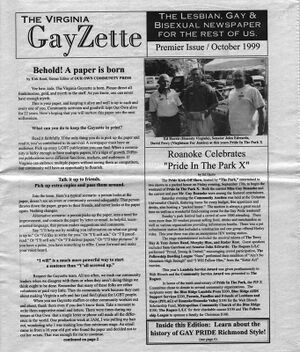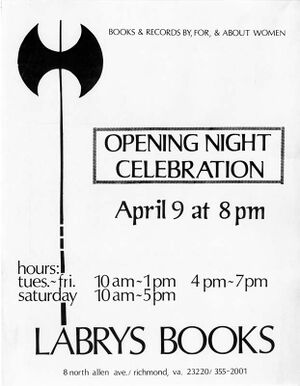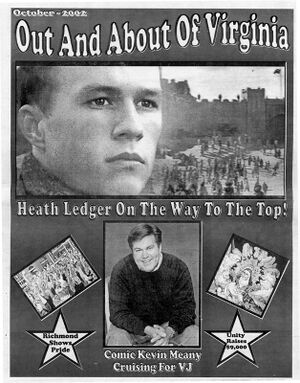Difference between revisions of "Making Connections: Written Materials"
m (Protected "Making Connections: Written Materials" [edit=sysop:move=sysop]) |
|||
| (10 intermediate revisions by one other user not shown) | |||
| Line 1: | Line 1: | ||
| − | As the community developed there was an increasing need and desire to be able to know what was happening within the community. The Richmond Lesbian Feminists developed their own newsletter “The Feminist Flyer” and GAP produced the GAP Rap; The Gap Rap was the first news and information medium distributed to Richmond’s lesbian and gay community. It was edited by Butch Chilton and was distributed almost monthly from April 1974 – April 1978. <ref>ref name=Marschak and Lorch> | + | As the community developed there was an increasing need and desire to be able to know what was happening within the community. The Richmond Lesbian Feminists developed their own newsletter “The Feminist Flyer” and GAP produced the GAP Rap; The Gap Rap was the first news and information medium distributed to Richmond’s lesbian and gay community. It was edited by Butch Chilton and was distributed almost monthly from April 1974 – April 1978. <ref>ref name=Marschak and Lorch>Beth Marscak and Alex Lorch, Lesbian and Gay Richmond, Charleston, SC: Arcadia Publishing, 2008. p. 40</ref> In 1977, the Gay Rights Association also began to publish its own newsletter. <ref>ref name=Marschak and Lorch. p. 56</ref> |
| − | In addition, a more comprehensive “real” paper also began. “Our Own” Community News began in July 1976 | + | [[Image:gayzette.jpg|thumb|The Virginia Gayzette began publishing in 2009. Credit ML]]In addition, a more comprehensive “real” paper also began. ''“Our Own” Community News'' began in July 1976; ''Our Own'' was started by the Unitarian Universalist Gay Caucus of the Unitarian Church in Norfolk, Virginia. Although it began as a mimeographed sheet, it became a statewide publication within a year, by 1977. In 1982, Our Own became independent of the UUGC. Our Own published until August 1998, and was one of the oldest existing LGBTQ newspapers when it stopped publishing. <ref>ref name=Marschak and Lorch. p. 48</ref> Our Own is a primary source of information about events and activities in the era it was published. It should be noted that through the mid 1980s, Our Own generally did NOT have bi-lines for most of their articles, perhaps to help protect the identity of the writers. |
| − | + | [http://www.gayrichmond.com/images/pdf/ourown.pdf Our Own Community News, August 1, 1976. Adobe PDF file - 1 MB] | |
| − | References | + | [[Image:labrys.jpg|thumb|left|Poster for the opening of Labrys Books. Credit ML]]Another important development for the women’s community in Richmond was the opening of Labrys Books on April 9, 1978 at 8 North Allen Avenue. Founded by Theresa “Terry” Barry and Joan Mayfield, who were active in the Women's Center, Labrys sold books by and for women and, along with churches like Pace Memorial Methodist, Richmond Friends and the First Unitarian Universalist Church, served as a meeting space for feminists and lesbians in Richmond. Labrys closed in 1981 and Womensbooks, a feminist owned cooperative bookstore started at the YWCA on North 5th Street in the Winter of 1981. WomensBooks later moved to the basement of the Fare Share Food Cooperative on Main Street. Selections included many lesbian books and music when they were hard to find in Virginia. <ref>ref name=Marschak and Lorch. p. 62</ref> WomensBooks operated until 1993, closing shortly after Phoenix Rising opened. Phoenix Rising was and is a bookstore serving the entire LGBTQ [[Image:outabout.jpg|thumb|Out and About was a monthly paper through 2008. Credit ML]]community. Phoenix Rising, run by Jim Todd and Rex Harrison, still operates on Belmont Avenue in Richmond, struggling in this age of easy online access and access in “big box” bookstores such as Borders and Barnes and Noble. |
| + | |||
| + | Richmond also had several other resources including ''The Richmond Pride'', the newsletter of the Virginia Gay Alliance. The Richmond Pride focused mostly on Richmond, but did include some state-wide and national news. It was published from August 1986 through early 1990 (the latest edition found was February 1990). In the end ''The Richmond Pride'' ceased to exist for lack of money as did Our Own. | ||
| + | |||
| + | Both ''Our Own'' and ''The Richmond Pride'' did not publish bi-lines for many of it's articles through out their history. This may have been an attempt to protect the identity of writers who were interested in helping, active in the "underground" gay culture, but who were not in a position to "out" themselves altogether. There were some articles that did list authors and others that did not. Most of Our Own articles by the mid 1980s did list bi-lines. | ||
| + | |||
| + | In addition, many of the organizations did publish newsletters that went to members including Dignity/Integrity, Lesbian Women of Color, Richmond Lesbian Feminists and more. The value of these publications and bookstores cannot be truly measured, but they were a vital lifeline in connecting people before the computer/online era. | ||
| + | |||
| + | <div style="text-align:right; font-weight:bold;">Next Article [[RLF Makes a National Impact: International Womens Year]]</div> | ||
| + | <div style="text-align:right; font-weight:bold;">Return to [[Rainbow Richmond: LGBTQ History of Richmond, VA]] home page</div> | ||
| + | |||
| + | ===References=== | ||
<references/> | <references/> | ||
| + | |||
| + | <comments /> | ||
Latest revision as of 11:10, 1 May 2010
As the community developed there was an increasing need and desire to be able to know what was happening within the community. The Richmond Lesbian Feminists developed their own newsletter “The Feminist Flyer” and GAP produced the GAP Rap; The Gap Rap was the first news and information medium distributed to Richmond’s lesbian and gay community. It was edited by Butch Chilton and was distributed almost monthly from April 1974 – April 1978. [1] In 1977, the Gay Rights Association also began to publish its own newsletter. [2]
In addition, a more comprehensive “real” paper also began. “Our Own” Community News began in July 1976; Our Own was started by the Unitarian Universalist Gay Caucus of the Unitarian Church in Norfolk, Virginia. Although it began as a mimeographed sheet, it became a statewide publication within a year, by 1977. In 1982, Our Own became independent of the UUGC. Our Own published until August 1998, and was one of the oldest existing LGBTQ newspapers when it stopped publishing. [3] Our Own is a primary source of information about events and activities in the era it was published. It should be noted that through the mid 1980s, Our Own generally did NOT have bi-lines for most of their articles, perhaps to help protect the identity of the writers.
Our Own Community News, August 1, 1976. Adobe PDF file - 1 MB
Another important development for the women’s community in Richmond was the opening of Labrys Books on April 9, 1978 at 8 North Allen Avenue. Founded by Theresa “Terry” Barry and Joan Mayfield, who were active in the Women's Center, Labrys sold books by and for women and, along with churches like Pace Memorial Methodist, Richmond Friends and the First Unitarian Universalist Church, served as a meeting space for feminists and lesbians in Richmond. Labrys closed in 1981 and Womensbooks, a feminist owned cooperative bookstore started at the YWCA on North 5th Street in the Winter of 1981. WomensBooks later moved to the basement of the Fare Share Food Cooperative on Main Street. Selections included many lesbian books and music when they were hard to find in Virginia. [4] WomensBooks operated until 1993, closing shortly after Phoenix Rising opened. Phoenix Rising was and is a bookstore serving the entire LGBTQ
community. Phoenix Rising, run by Jim Todd and Rex Harrison, still operates on Belmont Avenue in Richmond, struggling in this age of easy online access and access in “big box” bookstores such as Borders and Barnes and Noble.
Richmond also had several other resources including The Richmond Pride, the newsletter of the Virginia Gay Alliance. The Richmond Pride focused mostly on Richmond, but did include some state-wide and national news. It was published from August 1986 through early 1990 (the latest edition found was February 1990). In the end The Richmond Pride ceased to exist for lack of money as did Our Own.
Both Our Own and The Richmond Pride did not publish bi-lines for many of it's articles through out their history. This may have been an attempt to protect the identity of writers who were interested in helping, active in the "underground" gay culture, but who were not in a position to "out" themselves altogether. There were some articles that did list authors and others that did not. Most of Our Own articles by the mid 1980s did list bi-lines.
In addition, many of the organizations did publish newsletters that went to members including Dignity/Integrity, Lesbian Women of Color, Richmond Lesbian Feminists and more. The value of these publications and bookstores cannot be truly measured, but they were a vital lifeline in connecting people before the computer/online era.
References
<comments />


